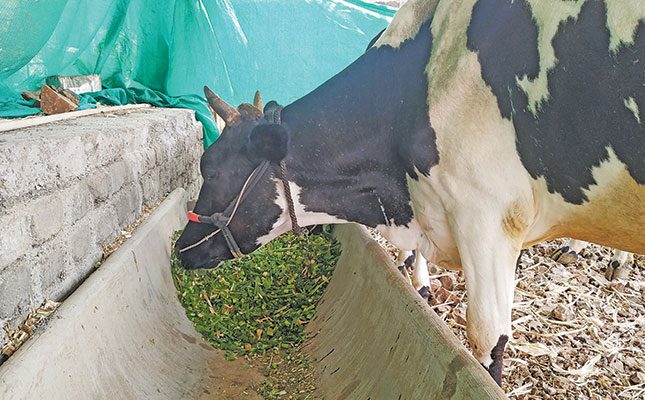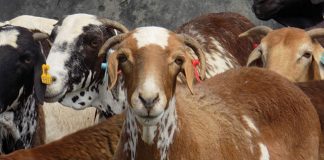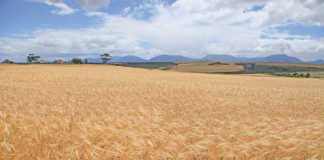
Photo: Wikimedia Commons
Livestock farmers have had a tough time over the past few years due to the high price of commodities, such as maize. These have led to an increase in the price of feed.
For most livestock operations, feed constitutes the largest percentage of all input costs, and an increase in the price of feed inevitably leads to a drop in a farmer’s profit margin.
When a farmer buys animal feed, he or she is not only paying for the commodities used in the feed, but also for the cost of processing. As such, many farmers have turned to mixing their own on-farm rations to help lower their feeding costs.
While it may seem like a good way to manage input costs more effectively, farmers should be cautious when deciding on this approach. Mixing feed is not simply a matter of putting a few ingredients together, particularly as livestock operations exist to make a profit.
Inferior feed will have a direct impact on the production efficiency of a farmer’s animals, and while a farmer may thus be saving money in the short term, mixing his or her own feed could end up costing him or her over the long term.
Formulating balanced and nutritionally appropriate feed requires a deep understanding of animal nutrition, as well as access to accurate nutritional information for various feed ingredients.
Without proper knowledge and resources, it’s challenging to ensure that the feed meets the animals’ specific needs.
It is also important to remember that animals’ feed requirements change depending on the stage of production they are in, and so it is also important for the farmer to fully understand what is required for each stage of production.
Inaccurate feed formulation can lead to nutritional imbalances that result in poor growth, reduced production, or health problems in animals. These imbalances can arise from incorrect ratios of energy, protein, vitamins, minerals, and other essential nutrients.
Moreover, mixing feed without proper equipment and quality control measures can lead to inconsistencies in ingredient distribution, resulting in animals receiving varying levels of nutrients. This can negatively affect animal health and performance.
Mixing your own feed can be time-consuming and labour-intensive. Farmers need to invest significant time in sourcing ingredients, formulating feed, and ensuring proper mixing, which could take away from other important farm activities.
Natural variations in feed ingredient composition can lead to fluctuations in nutrient content. Commercial feed manufacturers often use quality control measures to minimise these variations, ensuring consistent feed quality.
Commercial feed manufacturers often benefit from economies of scale, which allow them to purchase ingredients in larger quantities at lower costs.
On a small farm, it might be difficult to achieve the same cost savings. Mixing certain ingredients, such as additives or medications, without proper knowledge and precautions can pose health risks to both animals and humans handling the feed.
Despite this, there are some benefits to mixing feed on-farm, other than saving in costs. By mixing his or her own feed, a farmer is able to tailor-make feed specific to his or her animals.
Things to consider
Before investing in equipment to begin mixing feed, it is important to plan carefully. For starters, you need to determine whether mixing your own feed will be more beneficial for your animals than feeding commercial feed, or whether mixing your own feed will be more cost-effective.
As mentioned before, cost-effectiveness needs to be considered over the long term, as well as the short term. It is not worth saving a bit of money at the expense of overall production. This will ultimately end up costing you more.
If you choose to mix your own feed, begin by doing your research. Different animals have specific nutritional requirements based on their species, age, weight, and purpose.
You need to understand the nutritional needs of your animals before formulating your own feed. In this regard, you may want to consider consulting an animal nutritionist or a veterinarian.
They can provide insights into the specific nutritional needs of your animals and help you create a balanced and effective feed recipe.
Once you have a nutritional plan in place, you need to ensure you source high-quality ingredients. This will delay the eventual onset of rancidity and ensure the feed contains the correct nutrient components.
When mixing your feed, ensure that all ingredients are accurately weighed. A nutritional plan means nothing if the ingredients are not weighed, and nutrient consistency will be compromised.
Use a reliable scale and measure each ingredient precisely according to the recipe. It is also important to use a proper mixer to ensure uniform distribution of ingredients.
Choose a mixer that suits the volume of feed you’ll be producing. There are various types, such as horizontal mixers, vertical mixers, and paddle mixers.
Keep detailed records of the feed formulation, ingredient sources, and quantities used. This will help you track the effectiveness of your feed, troubleshoot issues, and make adjustments as needed.
When mixing, ensure good hygiene practices are followed to prevent contamination and spoilage. Sanitise your equipment to prevent the proliferation of harmful pathogens.
Once you have mixed your feed and begin incorporating it into your animals’ diets, you must monitor their performance. This means recording health, growth and production indices. Should your animals see a drop in performance, your feed composition may need to be adjusted accordingly.
Components of cattle feed
Cattle feed is composed of various ingredients that provide the necessary nutrients to support the growth, health, and productivity of cattle.
The specific components of cattle feed can vary based on factors such as the type of cattle (for example beef cattle, dairy cattle), their age, stage of production, and local availability of feed ingredients. Here are the main components typically found in cattle feed:
Focus on animal nutrition
Energy sources
- Maize
- Barley
- Sorghum
- Oats
- Wheat
- Molasses
- Soya bean hulls
Protein Sources
- Soya bean meal
- Canola meal
- Cottonseed meal
- Sunflower meal
- Distiller’s grains (maize or wheat)
- Lucerne meal
Forages
- Lucerne hay
- Grass hay
- Silage (maize, sorghum, grass, legumes)
- Pasture grasses
Minerals and Vitamins
- Calcium
- Phosphorus
- Magnesium
- Salt
- Trace minerals (zinc, copper, and selenium)
- Vitamins (A, D, E, K, and B)
Fats and oils
- Vegetable oils
- Animal fats
Fibre sources
- Beet pulp
- Wheat bran
- Rice bran
- Soya bean hulls
- Maize cobs
Additives and supplements
- Yeast cultures
- Probiotics and prebiotics
Enzymes
Growth promoters (only if approved and recommended by a veterinarian)
By-products
Distiller’s grains (from ethanol production)
Brewer’s grains (from brewing industry)
Citrus pulp
- Wheat middlings
It is important to note that the proportions of these components can vary based on the specific nutritional requirements of the cattle, their stage of production (such as growth, maintenance, lactation), and any existing deficiencies or excesses in their diet.
The goal is to formulate a balanced ration that provides the necessary nutrients in the right proportions to support optimal cattle health, growth, and production.
It is also recommended to work with a livestock nutritionist or veterinarian to formulate a customised feed plan that meets the unique needs of your cattle and to periodically review and adjust the feed formulation based on changing conditions and goals.
Visit feedstrategy.com.











